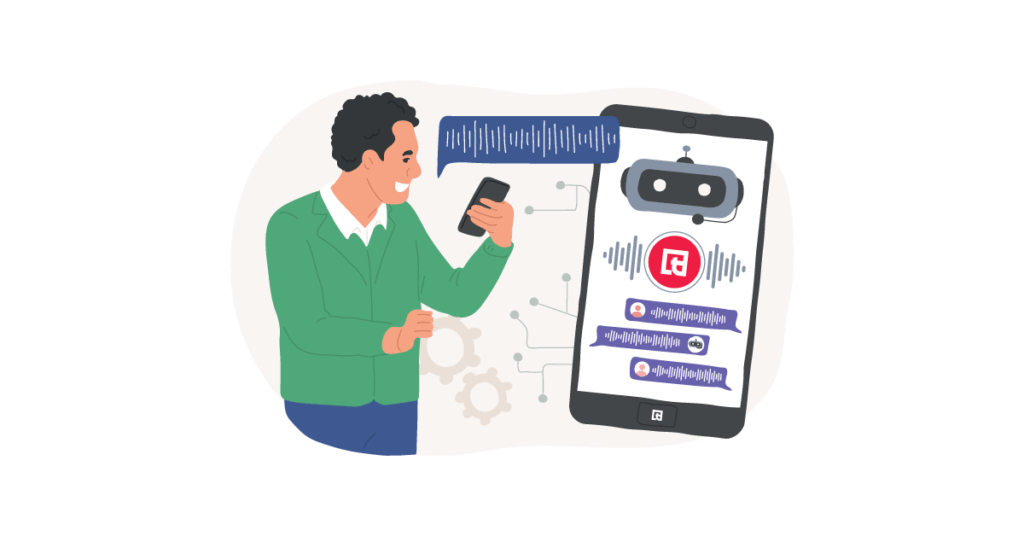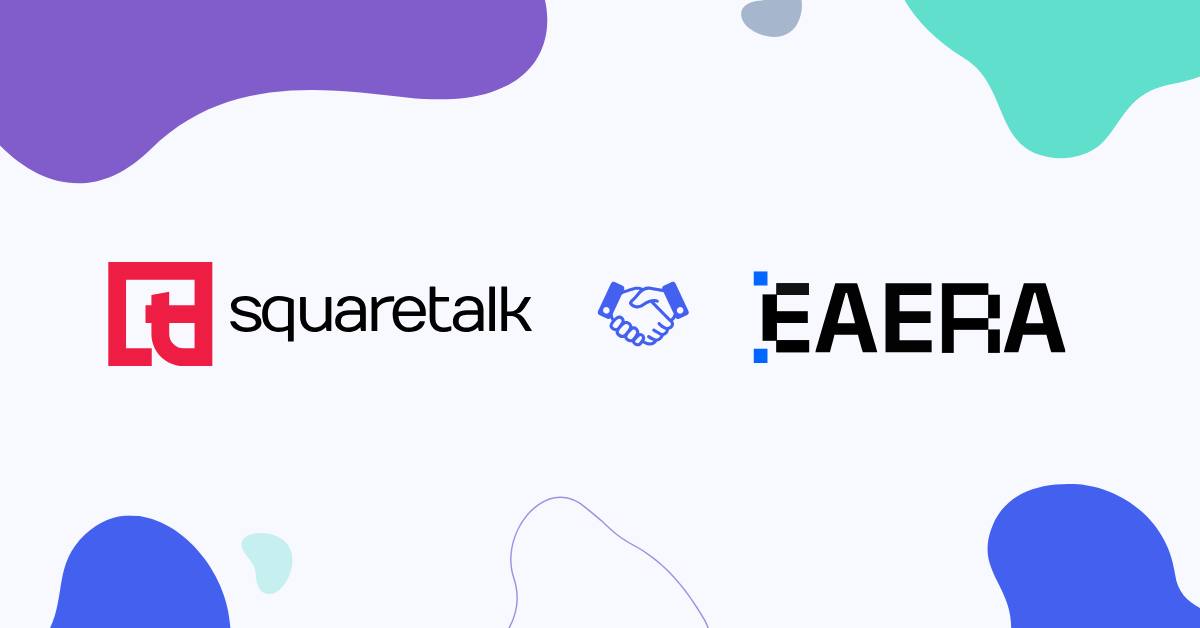“Do more with less while improving results” is an age-old sales challenge. Businesses have always tried to enhance efficiency, boost customer engagement, and drive more revenue without compromising quality or personalization, mostly with mixed results.
Today, new developments like AI voice agents offer an innovative way to automate conversations that once required a lot of human time and attention. What started as a way to automate routine calls has quickly evolved into a strategic tool to address bottlenecks, connect with prospects, nurture leads, and close deals.
But like any technology, its impact depends heavily on how you implement it.
So, let’s explore together how AI voice agents can help you build a smarter sales process, where in the customer journey they deliver the most value, and what limitations you need to plan around.
Factors Driving AI Voice Agents’ Adaptation in Sales
Traditional sales teams face a lot of challenges, like :
- Limited Coverage and Reach: Conventional sales processes rely heavily on individual interactions, and human agents can only make a finite number of calls during business hours. This leaves many prospects unattended or contacted too late, costing you high-intent opportunities, especially with inbound leads who expect immediate attention and easily move on to a competitor when frustrated.
- Inefficient Lead Qualification: Manual lead scoring and prioritization are often based on the agent’s skill level and subjective judgment. Without a structured process, reps waste time chasing and nurturing unqualified or low-intent prospects, which drains resources and lowers productivity.
- Time-Consuming and Repetitive Tasks: Sales agents often spend a significant portion of their time on manual tasks (e.g., initial outreach, lead qualification calls, appointment setting, data entry, etc.). This takes them away from building relationships and closing deals, contributing to burnout and loss of motivation.
- Varying Messaging and Service Quality: Human performance ranges due to many factors, like skills, stress, or mood, which can hinder the customer experience. Different agents may go off-script, forget key questions, mishandle common objections, or deviate from compliance language. This can have legal consequences in heavily-regulated industries, like FinTech, Healthcare, Debt collection, and Pharmaceuticals.
- Inconsistent Follow-Ups: According to research, 80% of sales require at least five follow-ups, yet 44% of agents stop after the first attempt. Failing to reach out again to a prospect altogether, doing it too late or too aggressively, using the wrong channel, sending generic and irrelevant messages, or skipping steps in the sales process can lower close rates and marketing ROI (return on investment), especially in longer sales cycles where lead nurturing is critical.
- Limited Scalability: Expanding traditional sales operations in size or new markets requires costly and slow recruiting of qualified sales professionals. Language and timezone barriers additionally hinder outreach and might require hiring local sales teams or relocating existing employees. And as your sales team grows, you need more managers and support staff, which adds to the operational costs and administrative work.
How AI Voice Agents Resolve Sales Bottlenecks and Challenges
AI voice assistants can operate 24/7, including evenings, weekends, and holidays, reaching and engaging with leads and customers across different time zones and languages. They can make thousands of outbound calls or handle inbound inquiries simultaneously. This maximizes your outreach, ensures you don’t miss touchpoints, and shortens speed-to-lead.
The AI agents use structured, data-driven protocols to quickly and consistently qualify leads in real time without missing steps. They filter out low-potential prospects, so your sales reps can focus on high-value opportunities. This increases overall productivity and conversion rates.
Automating mundane and repetitive tasks frees up human staff for high-value interactions that require emotional intelligence. When AI voice agents handle the bulk of admin work, your sales team has more time to close deals and build relationships.
AI voice agents can also automate follow-up sequences based on predefined schedules and lead behavior, thus reducing the risk of missed opportunities. They can re-engage cold leads, missed calls, or trial users based on set triggers.
Voice agents also deliver consistent and brand-aligned messaging, accurate information, and a predictable level of service quality across all interactions. They follow predefined scripts and adapt based on real-time data, ensuring compliance with industry regulations and internal standards.
Unlike traditional sales teams, AI voice agents can be deployed and scaled quickly and cost-effectively. During high-volume periods (like after events or marketing motions), they can instantly absorb increased demand without you hiring or training additional staff. AI voice campaigns can be cloned, localized, and adapted, allowing rapid expansion into new markets or audience segments with minimal investment.
Where AI Voice Agents Fit into the Sales Funnel
AI isn’t meant to entirely replace human sales reps but augment and enhance every stage of the sales funnel.
- Top of the Funnel: AI voice agents can run cold calling campaigns to approach new leads or re-engage unresponsive old ones from your CRM, collect data by asking BANT-style questions (Budget, Authority, Need, Timeline) to qualify them, and provide introductory information.
- Middle of Funnel: Once initial interest is detected, AI voice agents start nurturing leads with personalized content, detailed product information, real-time objection handling, and highlights of key advantages over alternatives the prospect may be considering. They schedule demos or meetings with human agents and follow up, keeping leads engaged and moving through the sales process.
- Bottom of the Funnel: AI voice agents assist by checking in after proposals or quotes have been sent, identifying additional decision-makers who need to be involved in the negotiations, and addressing remaining concerns. They can explain document or technical requirements, coordinate paperwork delivery methods, guide customers through complex forms or agreements, and alert human agents about pending contracts.
- Post-Purchase: After the deal, AI voice agents can be part of retention and revenue expansion, checking customer satisfaction, offering add-ons, asking for referrals, or doing renewal nudges and cross-sell campaigns. They can guide new customers through initial setup processes and arrange kickoff meetings with customer success teams.
Key Functions of AI Voice Agents in Sales
There are many tasks AI can perform in high-volume, conversion-driven environments. These actions mirror the daily activities of human sales reps, but voice agents execute them with more speed, consistency, and scale.
1. Automated Outbound Calling and Lead Engagement
The AI voice agent makes initial cold calls to potential customers from marketing lists, CRM databases, or behavioral triggers (e.g., website form fills). It can handle multiple calls in parallel, 24/7, to maximize contact rates and generate first touchpoints at scale.
After the lead answers, the AI voice agent greets them with a natural, human-like voice and uses NLP to extract meaning and Natural Language Understanding (NLU) to interpret the intent, context, and nuances behind their words.
The voice agent introduces your product or service based on pre-set scripts with value propositions and unique selling points. After asking some initial qualifying questions to confirm the prospect’s interest and understand their basic needs, it can route them to a human sales representative or schedule follow-up interactions.
If the lead doesn’t answer the call, the AI voice agent can leave a voicemail with a message based on campaign guidelines.
2. Lead Qualification
The AI agents do initial screening based on the likelihood of a lead becoming a customer. They use standard frameworks like BANT or custom logic to score the prospect based on their answers and engagement level. This ensures sales reps only spend time on leads that meet the company’s ideal customer profile or show high potential for conversion.
Post-call, AI voice agents automatically update the lead’s qualification status in the CRM and provide a summary to the human sales representative.
3. Appointment Scheduling and Management
When a lead shows interest or passes the qualification process, the AI agent can:
- Offer calendar slots from integrated booking tools.
- Confirm a meeting with a sales rep.
- Send SMS or email confirmations with meeting details.
- Make reminder calls before the appointment.
- Reschedule or cancel meetings.
- Follow up after no-shows.
This moves prospects further down the sales funnel faster. Booking meetings, demos, or calls directly into sales reps’ calendars and updating the CRM with appointment details eliminates scheduling conflicts and administrative bottlenecks.
Also, read “5 Ways SMS Appointment Reminders are Good for Business”.
4. Follow-Up and Lead Nurturing
AI voice agents operate on a consistent, rule-based follow-up procedure to engage “not yet ready” leads, check in after demos, trials, and marketing events, or re-engage cold or dormant prospects with personalized outreach. This automation ensures timely engagement, eliminates gaps in outreach, and prevents lead leakage due to human oversight.
The AI agents can share new information or content relevant to the prospect’s interests, confirm if they understood the previously sent materials, and address basic questions about products, pricing, or system capabilities. Based on this information, the system can determine if the prospect’s situation or requirements have changed and escalate them to a human agent if needed.
5. Product Information and Basic Inquiries Handling
During the call, AI voice agents answer common questions and provide details about products or services, retrieving the information from knowledge bases or product catalogs. They can explain features, benefits, and pricing, or guide users through basic troubleshooting. You can easily update the messaging for promotions or legal changes.
AI voice agents are programmed to follow scripts and dialogue flows but use intelligent branching and real-time intent recognition to choose the right approved response based on lead input. This ensures compliance, human-like conversation flexibility, and personalization at scale.
6. Basic Objection Management
AI voice agents can address common concerns or doubts during the call. The system uses NLP and NLU to identify the objection, responds with a pre-programmed message taken from your campaign setup or knowledge base, escalates complex or unusual complaints to human agents, or offers alternate paths (e.g., to provide more information, schedule a demo, follow up at a different time).
This helps the automation maintain high conversational quality and overcome basic objections without involving a live sales rep.
7. Data Capture and CRM Updates
The AI voice agents gather information during conversations and update sales records to keep data clean, accurate, and ready for human action.
During or after every call, the system:
- Extracts key data points (e.g., lead contact information, pain points, specific requirements or objections, decision-making process, urgency level, etc.).
- Updates CRM or sales engagement platforms with real-time conversation details and notes.
- Logs outcomes (e.g., call status, categories, responses, next steps).
- Adds notes, tags, or custom fields based on conversation outcomes.
- Triggers automated workflows and creates task assignments for human follow-up when needed.
8. Multilingual and Regional Adaptation
AI voice agents support multiple languages and accents, which makes them accessible to more diverse customer bases. They can switch tongues based on the lead’s location or preference and offer region-specific greetings.
In combination with catering to local business hours, multilingual AI voice agents allow you to establish and expand global outreach without building separate teams.
9. Personalized Recommendations and Upselling/Cross-Selling
By analyzing customer data and purchase history, AI voice agents can suggest relevant products, services, tailored promotions, or updates to increase sales value and your revenue.
The system can:
- Use scripted logic for post-purchase engagement when the customer is most open to upgrading.
- Offer relevant and timely recommendations based on behavior or data signals, like pitching bundles close to a contract expiration date.
- Proactively check in with existing customers to improve their experience and increase the chances they’ll renew, refer, and expand their use of your product.
- Uncover hidden issues before they escalate and the client churns.
- Identify upselling opportunities by asking helpful, non-pushy questions like “Have you explored [advanced features] yet?”.
- Follow up on onboarding to reinforce feature adoption and increase retention and customer lifetime value.
10. Real-Time Analytics and Insights
Traditional sales calls rely on human input, which can be subjective, inconsistent, or poorly logged. In contrast, AI voice agents provide accurate, structured, and actionable insights from conversations (e.g., customer preferences, conversion per campaign, most common objections, buying signals, optimal time slots for engagement). This helps sales teams refine strategies and improve performance.
Every AI-led call is automatically transcribed and, when integrated with your CRM system, logged in real time without relying on manual notes and admin work. You can use the insights from the AI voice campaigns to generate reports and make data-based decisions.
AI agents follow structured but flexible scripts, which makes them perfect for A/B testing and fine-tuning. You can evaluate sales messaging, opening pitches, and objection rebuttals, which is hard to track reliably with human reps.
AI Voice Agents’ Limitations and Considerations
While AI brings value to sales operations, it’s essential to understand the obstacles and concerns we currently face for proper deployment, expectation-setting, and ROI alignment. This is especially important when positioning them in B2B, CCaaS, or compliance-driven industries.
Key Limitations
- Difficulty Handling Complex Conversations: AI voice agents struggle with negotiations, multi-step requests, multi-stakeholder sales, layered or off-script questions, nuanced language, ambiguous queries (e.g., I need to adjust my order), and consultations. This could lead to customer frustration with their generic or irrelevant responses, miscommunication, and missed opportunities.
- Lack of Emotional Intelligence: While AI voice agents can recognize basic sentiment cues through language analysis, they can’t fully grasp emotional context, understand the undercurrents driving purchase decisions, or display true empathy. These limitations can extend sales cycles, increase the need to transition to human representatives, and impact your conversion rates.
- Inability to Build Deep Relationships: AI voice agents can simulate politeness but lack the human traits needed for authentic rapport. This can affect sales performance, customer lifetime value, post-sales growth, and long-term client loyalty, especially in complex or high-touch industries, like wealth management, healthcare, enterprise software, and real estate.
- Customer Frustration with Automation: Many people can recognize they’re speaking with a bot, especially if the system’s capabilities are not top-quality. Negative bias usually leads to hang-ups, reduced engagement, and lost sales. Long-term customers, on the other hand, can feel devalued when contacted by automated systems for upsells or renewals and churn as a result.
- Trouble with Background Noise and Poor Audio: AI voice agents need higher sound quality than humans to accurately transcribe and interpret what the lead says, to trigger the correct response, and provide a good customer experience. Office chatter, traffic, or ambient noise can cause the AI to offer irrelevant information, not process crucial details, or slow the sales process. Over-filtering sometimes distorts the audio, causing the system to misinterpret words or phrases, which hurts lead qualification and follow-ups.
- Dependence on Data Quality and Training: The AI’s effectiveness is directly tied to the accuracy, completeness, and freshness of the information it learns from and operates on. This includes training materials, script logic, and CRM data. If the information is inaccurate, outdated, incomplete, or biased, the system will fail to recognize your ideal customer, missclassify intent, or mislead a prospect.
Key Considerations
1. Goal and Use Case Definition
It’s important to identify the tasks the AI could take over based on their ROI potential, the relevant KPIs, which stage(s) of the funnel the AI agents will focus on, and the expected outcomes. You can spot the best automation opportunities by analyzing historical sales and customer data.
Squaretalk Tip: Begin with a single use case, test and optimize, then expand. Simple, repetitive tasks (like BANT-based lead qualification, appointment scheduling, basic information delivery, and initial follow-ups) are excellent starting points.
2. Target Audience Suitability
Understanding and aligning the AI voice agent’s capabilities with the prospects’ demographics, technology comfort level, and needs is essential for maximizing engagement, relevance, and overall effectiveness. Some industries (like highly personalized luxury goods and sensitive financial services & advice) have strong norms around direct human interaction, where an AI might be perceived as less trustworthy or insufficient. In contrast, fast-paced, transactional industries (like E-commerce, Telecommunications, and Food Delivery) might find AI more acceptable.
Squaretalk Tip: Use AI voice agents for high-volume routine conversations (e.g., abandoned card, new product announcement, proactive upgrade offers, win-back campaigns for churned customers).
3. Data Quality
To be successful, AI voice agents rely heavily on clean, organized, and up-to-date data for personalization, targeting, and flow logic. The system must also adhere to regulations like GDPR and DNC lists.
Squaretalk Tip: Run a data audit and identify which real-life interactions, product information, FAQs, and objection-handling strategies the AI needs to learn from before launching a campaign.
4. System Integration and Workflow Alignment
You need a closed-loop system where AI-triggered actions are logged, routed, and trackable. Integrating the system with your existing CRM (like Zoho, Salesforce, Pipedrive, etc.), dialer, calendar, marketing automation platforms, and analytics tools will let you automatically log interactions, update lead statuses, access customer history in real time, and schedule demos or meetings.
Squaretalk Tip: Choose an AI provider that can handle your anticipated call volumes, perform reliably during peak times, and scale with your business.
5. Script Design and Conversation Flows
Tailored, natural-sounding, and adaptable scripts help you cover different customer situations (like new prospects, existing customers, and special offers). The conversation flow needs to handle a variety of customer responses, including common objections, questions, unexpected script deviations, misunderstandings, or when the AI can’t understand the user.
Squaretalk Tip: Regularly A/B test different phrasing and approaches based on data from both the AI agent and your sales reps.
6. Human Escalation Paths
Clear and easy triggers (e.g., confusion, high intent, emotional frustration) and pathways for transfer are essential when the AI reaches its limitations or the customer explicitly requests an escalation. The transition needs to be warm when the sales rep is live. When no one is available or it’s after business hours, the voice agent should offer a callback or to book a meeting.
Squaretalk Tip: Use familiar voice patterns (e.g., “Give me a second while I bring in someone from the team…” instead of robotic prompts like “You will now be transferred.”) and align the AI voice and human rep tone to make the transfer seamless for the prospect.
Also, read “Your Ultimate Guide to Call Center Escalation: Process, Flow, and Best Practices”.
7. Performance Tracking and Reporting
Without robust monitoring, it’s impossible to accurately measure the AI’s effectiveness, identify what needs tuning, or prove ROI to stakeholders. Real-time dashboards, campaign-level reporting, sales funnel attribution, and escalation reports will help you track KPIs and provide additional insights like script drop-off points and lead disposition breakdowns.
Squaretalk Tip: Use reporting data to refine messaging, improve conversation flows, and optimize campaign timing.
The Future of AI Voice Agents in the Sales Ecosystem
AI technology is rapidly evolving. Feature upgrades and new capabilities will enable voice agents to transition from virtual assistants to highly integrated, intelligent, and emotionally aware sales tools.
Soon, the companies gaining a competitive advantage won’t be those with the most advanced technology, but those who’ve thoughtfully designed the workflows between the automation systems and human teams. AI’s role will expand to the whole sales cycle, taking on more tasks before, during, and after closing the deal.
AI voice agents will become better at initial lead qualification, going beyond BANT to understand more nuanced needs and fit, and transferring the call to a human when the system determines a lead is ready.
In the very near future, new sales hires will become productive quicker with AI assistance, personalized training, and data-driven coaching. The system will provide ongoing guidance with in-call insights and situational awareness. AI will also be able to flag accounts that show buying signals and suggest products or features based on integrated customer data.
The new models will be able to express a range of emotions, further blurring the line between human and AI communication. AI voices will become virtually indistinguishable from human ones, incorporating more natural intonation and regional accents, helping you enter new markets at low cost with minimal staff. Customer frustration with “robotic” interactions will also lower, improving rapport and making the AI agent’s presence less jarring, especially in initial contact and qualification calls.
Soon, AI voice agents will start collaborating with other AI systems (e.g., a predictive analytics engine, a CRM enrichment bot, a dynamic pricing AI) and integrate across various channels (chat, email, social media) to provide a truly omnichannel sales experience.
At the same time, the seamless integration of complex AI software with legacy systems will continue to be a challenge.
As automation becomes more sophisticated, there will be more emphasis on ethical guidelines, transparency, and compliance. Regulations around letting customers know they’re speaking to an AI, protecting data privacy, and mitigating bias will become more standardized. Clear opt-out and escalation paths will become even more important than they are now, as customer trust will be a strong differentiator in AI-led sales.
Also, read “Multichannel vs Omnichannel: A Comprehensive Guide for Sales Teams“.
Final Words
AI voice agents are no longer a futuristic concept but a present-day necessity for advanced sales automation, data analysis, and initial lead contact.
However, their true power lies in the collaboration between human judgment and machine precision. By strategically leveraging AI, you free your sales team to focus on building deeper client relationships, navigating complex deals, and providing more value.
Despite the current technical challenges and limitations, advancements in AI empathy and contextual understanding are rapidly narrowing the gap between automation and human connection. As voice agents evolve, they’ll move more and more from transactional tools into strategic partners, improving sales efficiency, customer experience, and revenue growth.








